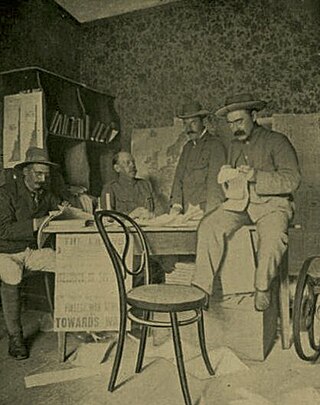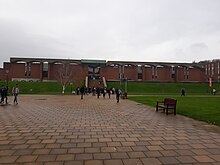
Forgotten Futures is a role-playing game created by Marcus Rowland to allow people to play in settings inspired by Victorian and Edwardian science fiction and fantasy. Most of its releases begin with these stories then add background material to explain the settings, adventures, and other game material.

Joseph Rudyard Kipling was an English novelist, short-story writer, poet, and journalist. He was born in British India, which inspired much of his work.
This is a bibliography of works by Rudyard Kipling, including books, short stories, poems, and collections of his works.

A Zeppelin is a type of rigid airship named after the German inventor Ferdinand von Zeppelin who pioneered rigid airship development at the beginning of the 20th century. Zeppelin's notions were first formulated in 1874 and developed in detail in 1893. They were patented in Germany in 1895 and in the United States in 1899. After the outstanding success of the Zeppelin design, the word zeppelin came to be commonly used to refer to all forms of rigid airships. Zeppelins were first flown commercially in 1910 by Deutsche Luftschiffahrts-AG (DELAG), the world's first airline in revenue service. By mid-1914, DELAG had carried over 10,000 fare-paying passengers on over 1,500 flights. During World War I, the German military made extensive use of Zeppelins as bombers and as scouts. Numerous bombing raids on Britain resulted in over 500 deaths.

An airship or dirigible balloon is a type of aerostat or lighter-than-air aircraft that can navigate through the air under its own power. Aerostats gain their lift from a lifting gas that is less dense than the surrounding air.

"The Man Who Would Be King" (1888) is a story by Rudyard Kipling about two British adventurers in British India who become kings of Kafiristan, a remote part of Afghanistan. The story was first published in The Phantom 'Rickshaw and Other Tales (1888); it also appeared in Wee Willie Winkie and Other Child Stories (1895) and numerous later editions of that collection. It has been adapted for other media a number of times.

The Jungle Book (1894) is a collection of stories by the English author Rudyard Kipling. Most of the characters are animals such as Shere Khan the tiger and Baloo the bear, though a principal character is the boy or "man-cub" Mowgli, who is raised in the jungle by wolves. Most stories are set in a forest in India; one place mentioned repeatedly is "Seeonee" (Seoni), in the central state of Madhya Pradesh.
Narrative exposition, now often simply exposition, is the insertion of background information within a story or narrative. This information can be about the setting, characters' backstories, prior plot events, historical context, etc. In literature, exposition appears in the form of expository writing embedded within the narrative.

Rudyard Kipling's The Jungle Book, also known as The Jungle Book, is a 1994 American adventure film co-written and directed by Stephen Sommers, produced by Edward S. Feldman and Raju Patel, from a story by Ronald Yanover and Mark Geldman. It is a live-action adaptation of the Mowgli stories from The Jungle Book (1894) and The Second Jungle Book (1895) by Rudyard Kipling, alongside Walt Disney's animated feature film of the same name from 1967; unlike its counterparts, the animal characters in this film do not talk.

The Norge was a semi-rigid Italian-built airship that carried out the first verified trip of any kind to the North Pole, an overflight on 12 May 1926. It was also the first aircraft to fly over the polar ice cap between Europe and America. The expedition was the brainchild of polar explorer and expedition leader Roald Amundsen, the airship's designer and pilot Umberto Nobile and the wealthy American adventurer and explorer Lincoln Ellsworth who, along with the Aero Club of Norway, financed the trip, which was known as the Amundsen-Ellsworth 1926 Transpolar Flight.

Perceval Landon (1869–1927) was an English writer, traveller and journalist, now best remembered for his classic and much reprinted ghost story "Thurnley Abbey".

The Aerial Board of Control is a fictional supranational organization dedicated to the control and aid of airship traffic across the whole world. It was first described in the science fiction novella by Rudyard Kipling, "With the Night Mail" (1905), and later in "As Easy as ABC" (1912.)

Dirigible is a 1931 American pre-Code adventure film directed by Frank Capra for Columbia Pictures and starring Jack Holt, Ralph Graves and Fay Wray. The picture focuses on the competition between naval fixed-wing and airship pilots to reach the South Pole by air.
Robert Roger Ingpen AM, FRSA is an Australian graphic designer, illustrator, and writer. For his "lasting contribution" as a children's illustrator he received the biennial, international Hans Christian Andersen Medal in 1986.

Jungle Book is a 1942 independent Technicolor action-adventure film by the Korda brothers, loosely adapted from Rudyard Kipling's The Jungle Book (1894). The story centers on Mowgli, a feral young man who is kidnapped by villagers who are cruel to the jungle animals as they attempt to steal a dead king's cursed treasure. The film was directed by Zoltán Korda and produced by his brother Alexander, with the art direction done by their younger brother Vincent. The screenplay was written by Laurence Stallings. The film stars Sabu as Mowgli. Although the film is in the public domain, the master 35mm elements are with ITV Studios Global Entertainment. An official video release is currently available via The Criterion Collection.

Marcus L. Rowland is an English retired laboratory technician and a notable author in the field of role-playing games, particularly games with Victorian era content.

The America was a non-rigid airship built by Louis Mutin Godard in France in 1906 for the journalist Walter Wellman's attempt to reach the North Pole by air. Wellman first conceived of using a balloon to fly to the pole during a failed polar attempt by boat and sledge from Svalbard in 1894. He then visited Paris to review the state of balloon technology but left disappointed by the lack of acceptable steering and propulsion capability. A decade later while at the 1905 Portsmouth Peace Conference he learned of recent innovations in French dirigible design and believed a solution might be at hand for his Arctic aerial plan. After receiving the backing of newspaper publisher Victor F. Lawson, the Wellman Chicago Record-Herald Polar Expedition was announced, and Wellman traveled to Paris in search of a suitable design and manufacturer. In the meantime a public company was established to raise the $US 250,000 required for the expedition and airship.

Henry Reuterdahl was a Swedish-American painter highly acclaimed for his nautical artwork. He had a long relationship with the United States Navy.

Joshua Glenn is an American writer, editor, and semiotics analyst. He is the cofounder of the websites HiLobrow, Significant Objects, and Semionaut. In the 1990s he published the zine Hermenaut.
The year 1905 was marked, in science fiction, by the following events.






















